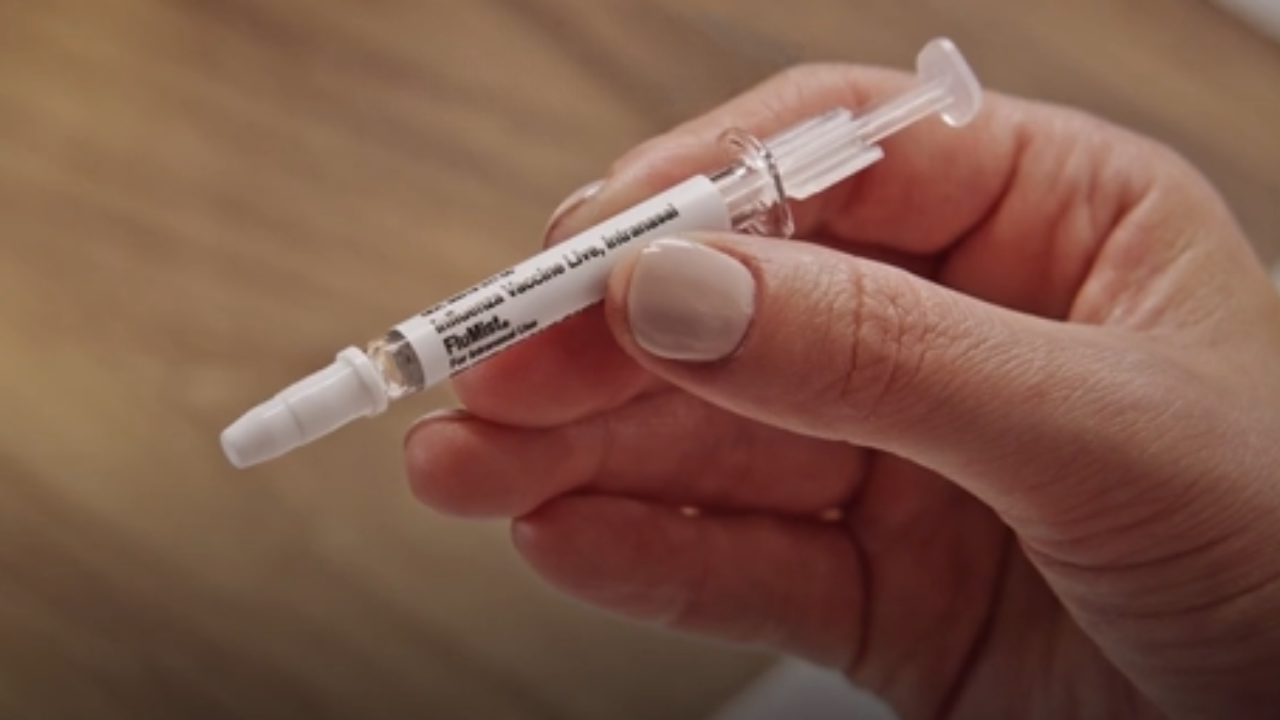- Health Conditions A-Z
- Health & Wellness
- Nutrition
- Fitness
- Health News
- Ayurveda
- Videos
- Medicine A-Z
- Parenting
Flu Nasal Sprays Now Available For At-Home Delivery: Know Risks, Precautions And Side Effects

(Credit-Canva, FluMist)
As harmless as it may seem, flu has been classified as high severity in 2024-25 across all ages, according to the National Foundation for Infectious Diseases (NFID). Amidst the rising number of cases, we may have an easy at-home way to deal with it.
AstraZeneca has launched FluMist Home, a new service that delivers the FLUMIST nasal spray flu vaccine right to your house. This is a game-changer, as it's the first time an influenza vaccine can be sent directly to customers for at-home use.
FLUMIST, a needle-free nasal spray, has been approved by the FDA since 2003. Now, it is also the first flu vaccine approved for people ages 18-49 to give to themselves, or for parents and caregivers to give to children ages 2-17. This new service aims to make it easier for people to get vaccinated and stay protected, especially after the last flu season was one of the worst in years.
Will This At-Home Service Help Lower Flu Cases?
According to NFID, 47 million flu related, 21 million medical visits, 610,000 hospitalizations and 27,000 deaths, which include 266 pediatric deaths happened during the flu season of 2024-25.
AstraZeneca and healthcare experts believe this new service will help more people get vaccinated. It makes flu shots more convenient and removes the need to go to a doctor's office or pharmacy.

Who Should Not Take the Flu Nasal Spray?
According to the FluMist Safety Information available on their site, you should not get the FLUMIST vaccine if any of the following apply to you:
- You have a severe allergy to the vaccine's ingredients, to eggs, or to other flu vaccines.
- You are a child or adolescent between 2 and 17 years old and are currently taking aspirin or aspirin-containing medicines. Children in this age group should not be given aspirin for four weeks after getting FLUMIST unless a doctor says it's okay.
- You are under 2 years old, as there's a higher risk of wheezing (trouble breathing) in this age group after getting the vaccine.
What Precautions Do You Need For the Flu Nasal Spray?
For the 2025-26 flu season, FluMist Home is available in 34 states. AstraZeneca plans to expand the service to all 48 states in the future. FLUMIST will still be available at doctors' offices and pharmacies. Before getting FLUMIST, it's crucial to tell your healthcare provider about all your medical conditions. This includes if you:
- Are currently wheezing or have a history of wheezing (especially if you're under 5 years old).
- Have asthma.
- Have a weakened immune system or live with someone who has a severely weakened immune system.
- Have had Guillain-Barré syndrome (a condition that causes severe muscle weakness).
- Have problems with your heart, kidneys, or lungs.
- Have diabetes.
- Are pregnant or nursing.
- Are taking antiviral drugs to treat the flu.

What Are The Side-Effects of The Flu Nasal Spray?
While most side effects are mild, FLUMIST can cause rare but serious reactions. The most common side effects are a runny or stuffy nose, sore throat, and a fever over 100°F.
Rare, serious side effects can include allergic reactions. If you experience hives, swelling of your face, lips, eyes, tongue, or throat, or have trouble breathing, seek medical help immediately.
Amid CDC Anti-Vaxxer Deputy Pick and School Vaccine Law Ruling, Third Unvaccinated Kentucky Infant Dies

Credits: iStock
The nation debate around vaccine has intensified in the US, and this week, it has taken a sharper turn as three separate developments have coincided in the country, all concerned with the administration of vaccines. Amid the controversial appointment of nation's top public health agency - the Centers for Disease Control and Prevention (CDC), and a major court ruling on school vaccine requirement in West Virginia, a third case of unvaccinated infant death is reported from Kentucky. The health officials confirm that the infant died of whooping cough, a vaccine preventable disease, which has reignited the debates around the use of vaccine.
Kentucky Confirms Third Unvaccinated Infant Death
While national debates continue, Kentucky is facing a direct and heartbreaking consequence of falling vaccination rates. Health officials have announced the death of another infant from whooping cough, bringing the total to three deaths in the past 12 months. The first two represented the state’s first pertussis deaths since 2018.
The Kentucky Department for Public Health did not disclose where the most recent death occurred. Officials expressed deep concern about the surge in cases and urged families to stay up to date on recommended vaccines. They stressed that vaccination protects not only individuals but also those who are too young or medically unable to be vaccinated.
As of November 19, Kentucky has recorded 566 pertussis cases this year. Infants under one year old face the highest risk of severe illness and death. The health department confirmed that none of the infants who died had been vaccinated, nor had their mothers received the recommended maternal pertussis shot during pregnancy.
Whooping cough begins with mild cold-like symptoms but can progress within weeks to violent coughing fits that make it hard for babies to breathe. Doctors warn that vaccination in pregnancy and infancy remains the most effective way to protect the youngest children.
A Controversial Choice Inside the CDC
The death of an unvaccinated child happened while anti-vaxxer Ralph Abraham, the former Louisiana surgeon general, was appointed as the new deputy director of the CDC. It has drawn immediate criticism. Abraham is now the second highest-ranking official at the agency, yet he has a long record of questioning mainstream vaccine guidance.
During the pandemic, Abraham openly supported the use of ivermectin, discouraged the birth dose of the hepatitis B vaccine and repeatedly criticized COVID-19 vaccines. While serving as Louisiana’s top health official, he instructed his department to stop promoting mass vaccination and stayed silent for two months during a pertussis outbreak that killed two infants earlier this year.
His appointment has alarmed public health experts, including his predecessor. Nirav Shah, who previously served as the CDC’s deputy director, told The New York Times that Abraham is not the right person for a role that involves leading emergency responses. Shah said that delaying public communication about infant pertussis deaths was unacceptable and called it shameful.
West Virginia Judge Expands Vaccine Exemptions
The debate over vaccine policy was further amplified after a judge in West Virginia ruled that the state must allow religious exemptions to its long-standing school immunization requirements. For decades, West Virginia has maintained one of the highest childhood vaccination rates in the country by permitting only medical exemptions.
Judge Michael E. Froble ruled that the policy violated the state’s religious freedom law, which was enacted two years ago. He said families who sought religious exemptions were being forced to choose between following their beliefs and accessing public education. His ruling now applies to all families who have previously requested religious exemptions.
The decision arrives at a time when measles and other vaccine-preventable illnesses are climbing nationwide. It also follows the appointment of Abraham to the CDC and ongoing remarks from Health Secretary Robert F. Kennedy Jr., who has repeatedly expressed skepticism about vaccine science. Together, these shifts are raising questions about how strongly the country’s health policies will hold in the coming years.
Ruth Codd Reveals She Is Recovering From Second Leg Amputation

Credits: Instagram
Ruth Codd, Irish actor and The Celebrity Traitors star revealed that she is now recovering from her second below-knee amputation. Codd, 29, was first shot to fame on TikTok during pandemic, and shared the news in a candid video on Wednesday.
What Happened To Codd's Leg?
She had her first leg amputated six years ago after a football injury in her teens, which led to repeated surgeries, chronic pain, and long-term mobility issues. Posting another video again from her parents’ home, she joked that her return to filming there felt like a “full circle moment,” but added that she could no longer record videos in her favorite room because it is upstairs.
"Just Had My Second Amputation"
In her TikTok update, Codd with a bit of humor revealed the news. “Good news, I’m back making TikTok content in my parents’ house. Bad news, I can’t do it in front of that lovely blue floral wallpaper any more, because I’ve just had my second below-knee amputation,” she said, adding, “So, a lot to unpack there for everyone involved.”
She also introduced her followers to her new wheelchair, affectionately named “Fat Tony,” joking that it has “the top speed of f*** all per hour, especially if there’s a step involved.” Her caption read: “No legs who dis? #paralympics2026.”
Codd’s latest surgery follows years of complications linked to her original injury. In a recent interview on FFTV’s YouTube channel, she revealed she had all her toes amputated in 2021. She had spent eight years relying heavily on crutches, which she said forced her to walk on her “tippy toes,” eventually destroying the joints in her foot.
Doctors had told her the foot would “never get any better,” and that worsening pain was making it increasingly difficult to work. “It’s gone past the point where they can do anything about it,” she told FFTV.
The Road To Recovery
The actor has spoken openly about the recovery process, explaining that she will have to wait at least a month for her limb to heal before she can begin using a prosthetic. Despite the challenges, her tone online remains upbeat and self-aware, reflecting the personality that first gained her a loyal audience during the Covid pandemic.
Codd’s TikTok content—often comedic sketches and videos promoting disability awareness, helped her amass more than 20 million likes in a year after she lost her job as a make-up artist and barber. Her success on the platform led her to acting roles in Netflix series The Midnight Club and The Fall of the House of Usher.
Earlier this year, Codd appeared in the first series of The Celebrity Traitors, where she impressed viewers with her sharp observations. She correctly identified Jonathan Ross as a “traitor,” but was ultimately eliminated in episode four. Reflecting on her time on the show, she described the experience as “surreal,” saying it still feels like she could “wake up from a very weird dream.” Despite the difficulties of her recent surgery, Codd continues to bring humor and openness to her situation, qualities that have defined her rise from TikTok creator to Netflix actor.
Jenny McCarthy Talks About The 'Growth' In Her Eyeball And Other Health Scare

Credits: Wikimedia Commons
Jenny McCarthy, American actress and model in an interview with People revealed her 'horrific' experience of having mouth infections. She is now feeling thankful for being able to eat the Thanksgiving turkey dinner.
What Happened to Jenny McCarthy?
She tells People, "I've had nine surgeries this year, on my mouth. I had one infection that turned into another and another, and then I had these growths show up on my eyeballs."
How it started? She said it all started with a failed ceramic dental implant. "My teeth were falling out, implants falling out. They finally had to dig into my jawbone and chipped away, and found I had a deep bone infection. I've been on antibiotics for a year, and have had to eat soft foods only."
While on the November 25 holiday card with she and her husband Donnie Wahlberg, McCarthy looked fit, she revealed that she had "two more mouth surgeries even after that photo was taken". She says that she had been "pretty unlucky".
Jenny's Health Now
"As of now, I am able to chew again," she says, "but every time we thought it had cleared up, it came back again. I'd be in massive pain with my jaw swelling up, and at the same time I was getting these growths popping up on my eyeball. People should actually feel a little sorry for me."
Now that she has been well, she is looking forward to celebrating Thanksgiving with her husband. "It's been a little tricky-wicky getting together," she says of balancing their busy schedules.
She revealed that she was shooting The Masked Singer in Los Angeles, and her husband was in Canada with Boston Blue. "So it's been tricky and difficult, which means Thanksgiving and Christmas will mean more to us than ever this year. It's just me and him, at home in Chicago, me cooking a bird, and enjoying each other," she says.
The best part? She says she will be able to enjoy much more than just mashed potatoes now that her mouth infections have cleared up. "I think I'm past the storm. I'm about to chow down," she says.
Can Dental Problems Lead To Eye Infections?
While McCarthy did not say what she actually had, she did refer that it all started with a "failed ceramic dental implant". Experts point out that due to their anatomical proximity, the eyes and teeth share many nerve and vascular connections. This is why, eye problems could follow a tooth infection.
An infection or a dental abscess of the tooth can easily by continuity spread and be the cause of uveitis, or the infection of uvea. It can also cause other infections in the tear duct, the orbit, lower eyelid, or more.
Studies have also shown that several roots of "spread" due to the infected tooth. For instance, infections in the incisors and canines will spread through the blood or cell. Whereas infections in premolars and molars spread further through the maxillary sinuses. There are 10 to 20% of maxillary sinusitis of dental origin.
Wisdom teeth can reach the lower orbital tissue of the eye, and infections and dental abscesses could spread by the subperiosteum or the set of layers of the periphery of the bones, along with the upper jaw to the tear duct. The infection or abscess can also open a look through the lower edge of the eye socket. This case is quite exceptional except in the case of severe sinusitis.
© 2024 Bennett, Coleman & Company Limited

